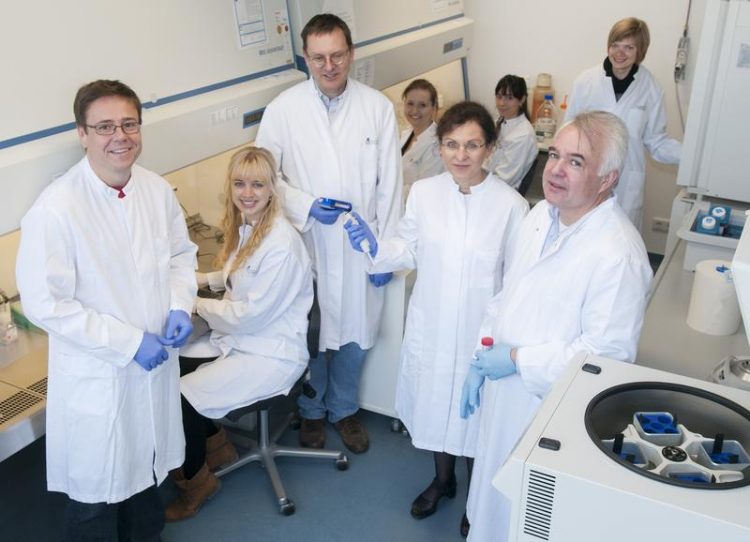Adenosine can melt "love handles"

In the lab: Dr. Thorsten Gnad, Saskia Scheibler, Prof. Dr. Alexander Pfeifer, Anja Glöde, Prof. Dr. Christa E. Müller, Laia Reverte-Salisa, Prof. Dr. Ivar von Kügelgen, Dr. Linda S. Hoffmann. Photo: Claudia Siebenhüner/UKB
An international team of researchers led by Professor Alexander Pfeifer from the University Hospital Bonn, have now come one step closer to this goal. The scientists discovered a new way to stimulate brown fat and thus burn energy from food: The body's own adenosine activates brown fat and “browns” white fat. The results are now being published in the renowned journal “Nature”.
“Not all fat is equal,” says Professor Alexander Pfeifer from the Institute of Pharmacology and Toxicology of the University Hospital Bonn. Humans have two different types of fat: undesirable white fat cells which form bothersome “love handles”, for example, as well as brown fat cells, which act like a desirable heater to convert excess energy into heat. “If we are able to activate brown fat cells or to convert white fat cells into brown ones, it might be possible to simply melt excess fat away” reports the pharmacologist.
The group of Prof. Pfeifer together with an international team from Sweden, Denmark, Finland, as well as from the Helmholtz-Center Dresden-Rossendorf and the University of Düsseldorf now discovered a new signalling molecule capable of activating brown fat cells: adenosine. Adenosine is typically released during stress. Crucial for transmitting the adenosine signal is the adenosine receptor A2A.
Adenosine activates brown adipose tissue
“If adenosine binds to this receptor in brown fat cells, fat burning is significantly stimulated,” reports Dr. Thorsten Gnad from Prof. Pfeifer's team. It was previously thought not possible for adenosine to activate brown fat. Several studies with rats and hamsters demonstrated that adenosine blocks brown fat.
However, the researchers from the University of Bonn were not mislead by these previous findings. In contrast, using brown fat cells removed from humans during surgery, the scientists investigated the signaling pathway for fat activation using adenosine. The results showed that rats and hamsters react differently than humans in this regard. “The brown fat in mice on the other hand behaves just as in humans,” summarizes Prof. Pfeifer.
“Browning” of white fat by adenosine
In addition, the research team investigated the possibility that adenosine transforms white fat cells into brown fat cells – a process termed “browning”. White fat cells normally cannot be induced to burn excess fat by adenosine, as they simply lack the A2A receptor. For this reason, the team of scientists transferred the A2A receptor gene from brown fat cells to white fat cells in mice. Consequently, the white fat cells also have A2A receptors and start browning and burning energy.
Clinical application is still far off
As a result, it was possible for the researchers from the University of Bonn to comprehend the significance of adenosine for brown cells in mice and humans for the first time. “Through the administration of adenosine-like substances, the mice actually lost weight,” reports Prof. Pfeifer. However, many questions in this regard still need to be investigated. For this reason, clinical application is still far off.
Publication: Adenosine activates brown adipose tissue and recruits beige adipocytes via A2A receptors, “Nature”, DOI: 10.1038/nature13816
Contact information:
Prof. Dr. Alexander Pfeifer
Institute of Pharmacology and Toxicology
University Hospital Bonn
Tel. 0228/28751300
E-Mail: alexander.pfeifer@uni-bonn.de
Media Contact
More Information:
http://www.uni-bonn.de/All latest news from the category: Health and Medicine
This subject area encompasses research and studies in the field of human medicine.
Among the wide-ranging list of topics covered here are anesthesiology, anatomy, surgery, human genetics, hygiene and environmental medicine, internal medicine, neurology, pharmacology, physiology, urology and dental medicine.
Newest articles

A universal framework for spatial biology
SpatialData is a freely accessible tool to unify and integrate data from different omics technologies accounting for spatial information, which can provide holistic insights into health and disease. Biological processes…

How complex biological processes arise
A $20 million grant from the U.S. National Science Foundation (NSF) will support the establishment and operation of the National Synthesis Center for Emergence in the Molecular and Cellular Sciences (NCEMS) at…

Airborne single-photon lidar system achieves high-resolution 3D imaging
Compact, low-power system opens doors for photon-efficient drone and satellite-based environmental monitoring and mapping. Researchers have developed a compact and lightweight single-photon airborne lidar system that can acquire high-resolution 3D…





















